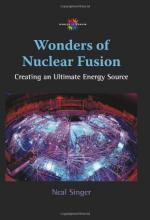|
This section contains 2,164 words (approx. 8 pages at 300 words per page) |

|
Nuclear fusion is the process by which two light atomic nuclei combine to form one heavier atomic nucleus. As an example, a proton (the nucleus of a hydrogen atom) and a neutron will, under the proper circumstances, combine to form a deuteron (the nucleus of an atom of "heavy hydrogen"). In general, the mass of the heavier product nucleus is less than the total mass of the two lighter nuclei.
When a proton and neutron combine, for example, the mass of the resulting deuteron is 0.00239 atomic mass unit less than the total mass of the proton and neutron combined. This "loss" of mass is expressed in the form of 2.23 MeV (million electron volts) of kinetic energy of the deuteron and other particles and as other forms of energy produced during the reaction. Nuclear fusion reactions are like nuclear fission reactions, therefore, in the respect that some...
|
This section contains 2,164 words (approx. 8 pages at 300 words per page) |

|


